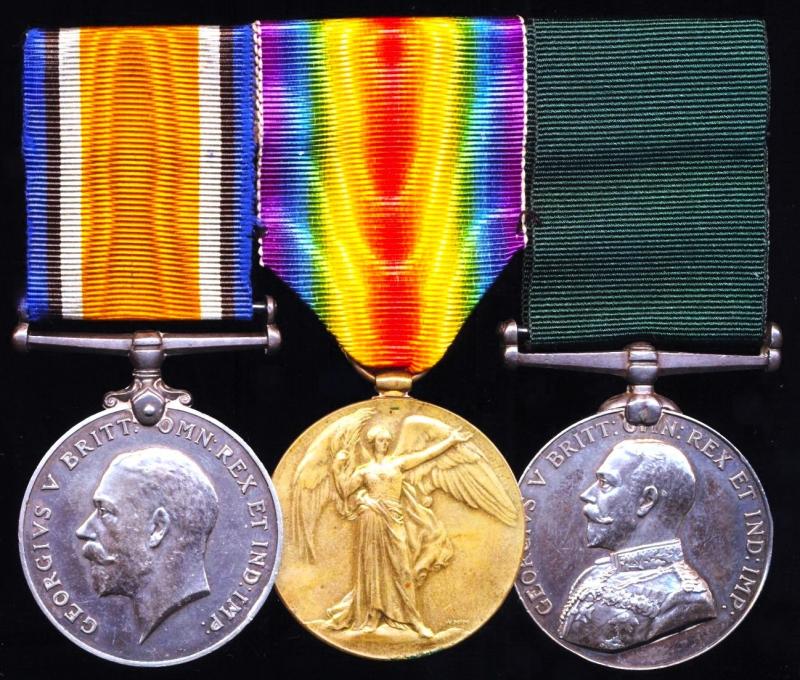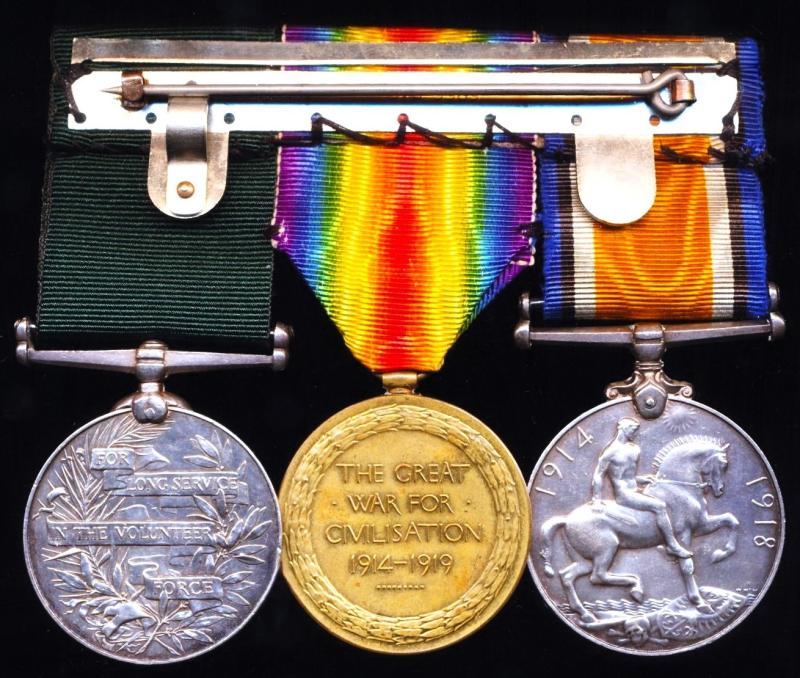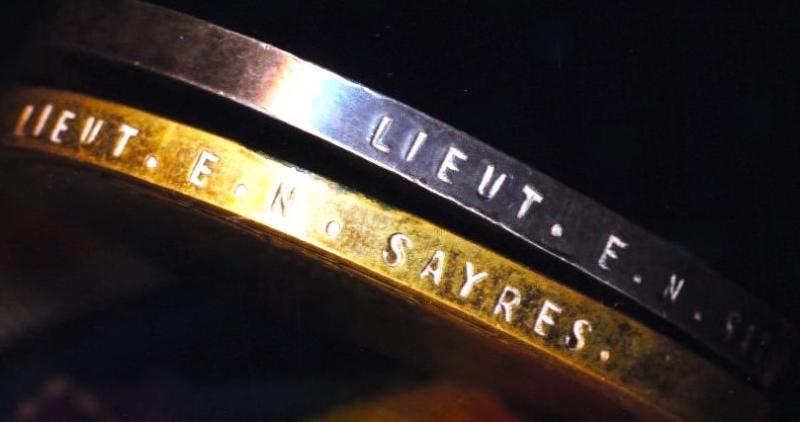A Calcutta 'Box Wallah's' Great War and Long Service Medal group of 3: Trooper Edward Hamilton Sayres, Calcutta Light Horse, late Indian Army Reserve of Officers attached 25th Cavalry (Frontier Force)
- British War Medal. Silver issue (Lieut. E. N. Sayres.)
- Interallied Victory Medal (Lieut. E. N. Sayres.)
- Volunteer Long Service Medal (for India and Colonies). GV issue (Tpr. E. H. Sayres, Cal. L.H., A.F.I.)
Note: The pair with second forename initial 'N' (sic) and exactly as issued by the Calcutta Mint
Edward Hamilton Sayres was a long time expatriate resident 'Tea Broker' & 'Tea Taster in Calcutta,British India. During the Second World War, in 1944, he was nominated as Steward of the Royal Calcutta Turf Club at Tollygunge - and a plum social gig at time when the City of Calcutta was bursting with allied British, Canadian and American 'Officers' either resident on 'Admin / Logistics' duties, and or on 'R & R' leave from the Burma front
A child of Empire, Edward Hamilton “Freddie” Sayres was the product of the marriage (1887 in Ceylon) between “Jack” Sayres and Jeanie Stephenson. Born in Ceylon Colony in 1889, he later became according to the Sayres family tree, a ‘Tea taster in Calcutta’. Edward established himself in Calcutta as a ‘Tea Broker’ with the large and long-established Tea Auctioneers Carritt Moran & Co. Apart from dealing with tea, the young Edward Sayres was clearly an excellent horseman. The Calcutta Light Horse” history (Gale & Polden, 1957) tells us that ‘Trooper E. H. Sayers’ (sic) won the “1911-12 Calcutta Light Horse Paperchase Challenge Cup”
The Nominal Roll of the Calcutta Light Horse for August 1914 showed that at the outbreak of the Great War, E. H. Sayres had reached the rank of Corporal. His name is juxtaposed with that of Trooper A. C. Sayres, his brother, who also subsequently served with the Indian Cavalry during the 1914-18 war (Capt.). After waiting three years before getting into the war, Edward Hamilton Sayres was commissioned into the Indian Army Reserve of Officers on 5 April 1917. His previous service was given as ‘Calcutta Light Horse, 6 years’, and that he had a ‘slight’ command of Hindustani. He is shown on the IARO (Cavalry) list as having the qualification ‘207a’ (Colloquial Hindustani). His younger brother “Sandy” had already joined the IARO in January 1917 and was immediately attached to the Deccan Horse (29th Lancers)
The London Gazette” of 22 June 1917 announced that ‘The King has approved the admission of Edward Hamilton Sayres of the Indian Army Reserve of Officers (Cavalry Branch), to be a Second Lieutenants, dated 5th April 1917. As a The newly-minted twenty-eight year old Second Lieutenant Sayres was attached to 33rd Cavalry
The unit to which Second Lieutenant Sayres was attached, was raised in 1820 as the 3rd Regiment of Bombay Light Cavalry. In 1903 it became the 33rd Queen Victoria’s Own Light Cavalry (and later amalgamated with the Poona Horse). The Poona Horse history lists E.H. Sayres, IARO, as being attached to 33rd Queen Victoria’s Own Light Cavalry on 23 April 1917, the unit having returned to India after lengthy service in Mesopotamia. 33rd Cavalry was stationed at Lahore, with a squadron at Multan. They left for Risalpur on 16 November 1917, however, by that time, 2nd Lieut. Sayres had gone overseas on 'Active Service', having transferred to 25th Cavalry (Frontier Force) on, 5 November 1917.
25th Cavalry went to East Africa in August 1917, three months before Lieut. Sayres joined. By November 1917, tsetse-fly had killed many of the 25th Cavalry horses and well over half of the Regiment was dismounted. By the time Lieut. Sayres reached the theatre of war, patrols of 25th Cavalry were being sent from German East Africa into Portugese East Africa to reconnoitre positions of Lettow-Vorbeck’s Schutztruppen. About this time, the departing 10th South African Horse gave its horses to 25th Cavalry, in addition to Remounts, allowing the unit to become fully-mounted again. In January 1918, the rains fell and the Rovuma River rose. All British troops south of the river were recalled back to German East Africa. The 25th Cavalry (Frontier Force) re-grouped and rode slowly back through the rain to Lindi Harbour. After handing in its horse and mules, the Regiment, after four months of campaigning in inhospitable conditions, embarked on HMT “Salamis” on 1 February 1918 and returned to India. Twenty-six members of the Regiment were killed or died of wounds or disease during the campaign in East Africa. Capt. J. Nethersole, MC, was awarded a Bar to his Military Cross; Captains W. K, Fraser-Tytler and N. S. Bruce, RAMC attached 25th Cavalry (Frontier Force), the Military Cross. In addition six IDSMs and eleven Mentions in Despatches were awarded (including Brevet Lt.-Col. G. A. R. Watts and Major P. W. Burrowes: the tempy. Comd. and temp. 2nd-in-Comd. respectively). In East Africa t is known that 25th Cavalry took part in operations at Nahungo and Chingwea. This was followed by the unit’s pursuit of forces led by the redoubtable German commander, von Lettow-Vorbeck, to the Portuguese African border
The London Gazette of 15 November 1918, carried the announcement of the King’s approval of promotions to the IARO, including E. H. Sayres (Lieutenant, 5 April 1918) and several other officers. At this stage, Lieut. Sayres had been transferred to the Infantry, namely 1/56th Punjabi Rifles (Frontier Force). The thirty-year old Sayres, however, was released from the IARO in July 1919, and returned to his employer, Carritt Moran & Co., by now situated at 9, Mission Row, Calcutta
In 1921, perhaps on furlough, Edward (“Freddie”) Sayres, together with his brother Capt. Alexander (“Sandy”) Sayres, both former “temporary gentlemen” and ex-cavalry officers, took passage from Bombay to London.
The London Gazette of 1 September 1922, belatedly published the King’s approval of resignations from the IARO. This included Lieutenant E. H. Sayres, who resigned with effect from 1 May 1922 and was permitted to retain the rank of Lieutenant. He continued his association with the Calcutta Light Horse, and subsequently qualified for the Volunteer Long Service Medal GVR (18 years’ service, war service counting double). This appeared in India Army Order № 789, dated 5 December 1928, ‘Approved by his Excellency the Commander-in-Chief in India. The Vol LS medal to Sayres was one of only 37 awarded to the Calcutta Light Horse, AFI
“Tea taster” Edward Sayres was clearly also a “man of the Turf” and had a long-term association with the Royal Calcutta Turf Club. Established in 1847 as the Calcutta Turf Club, it regulated all matters concerning racing and protecting the interests of the Turf in Calcutta (and later throughout most of India). Elections to the Club were by ballot, a committee of five being appointed to manage the affairs of the Club, with five Stewards to supervise the races. His association with the RCTC culminated in the years 1944 and 1945, with his holding office as a Steward of the Turf Club, being one of five notable personages. It seems likely that Sayres – at about the age of sixty – retired to Jersey after Indian Independence in 1947. However the Royal Calcutta Turf Club continued to thrive in his absence, and does so to this day – under exactly the same name
Edward Hamilton “Freddie” Sayres was married to Jessie Clara Sayres, née Alderman, but they had no children. Seven years after Indian Independence, it is known that Edward Sayres purchased land on Jersey from a certain T. W. Wright. This was on 6 March 1954
All 3 x medals mounted in the swing-style. The reverse of the mounting bar retaining the original long hinged pin and clasp fittings
Sold together with some soft-copy research that will be forwarded to the buyer by email attachment
Silver medals toned
Condition: GVF
Code: 24086






